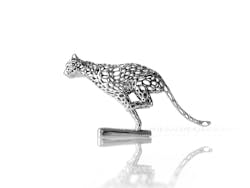Laser Melting Innovations GmbH & Co. KG (LMI), a spinoff of the Fraunhofer Institute for Laser Technology (Fraunhofer ILT; Aachen Germany), is one of the winners of the formnext Start-up Challenge 2019. A prototype of a low-cost system for laser powder-bed fusion (LPBF) was presented at formnext 2016—this additive manufacturing machine was produced as part of a project at the Aachen Center for 3D Printing. Dawid Ziebura, a research associate and project manager at Fraunhofer ILT, spotted an opportunity to commercialize a low-cost system aimed primarily at small- and medium-sized companies that would make it easier for them to enter the metal 3D printing business.
“We opted to use a diode laser instead of an expensive fiber laser,” explains Ziebura, “and to replace an expensive scanner systems with a Cartesian-motion laser system.” The prototype and the ideas for developing it were met with such enthusiasm at formnext that the project participants decided to create a spinoff company in 2017. However, they opted not to pursue the original concept of an affordable assembly kit, and instead focused on developing an industry-ready, low-cost LPBF system. “The argument against the original assembly kit idea was that the customer wouldn’t be satisfied even if they had a small, serviceable machine,” says Ziebura. “In most cases, it’s not their core competence, and adapting their manufacturing processes with the machine simply wouldn’t be a viable proposition during day-to-day operations. We realized they needed a fully functional tool they could rely on.”
“Suddenly, we were faced with a whole set of new challenges,” says LMI managing director Mirjam Henkel. “We had the process firmly in hand, but now we had to deal with tasks such as CE certification, design and marketing.” One year later, the startup company launched its fully functional Alpha 140 LPBF machine, which—together with the required peripheral parts—comes to less than 100,000 euros. As well as being a reliable, production-scale solution, it is also far more productive and powerful than the prototype. “The customer doesn’t just get the machine, but also everything he need to get started,” says Ziebura. “That includes the necessary data preparation software, which we developed in-house, as well as the peripheral equipment required for the process."The innovative system works in an argon/nitrogen inert gas environment and uses an air-cooled, fiber-coupled 200 W diode laser with a wavelength of 915 nm and a focus diameter of 140 µm. This entry-level model can be used for the additive manufacturing of parts with a maximum height of 200 mm and a maximum diameter of 140 mm using 1.4404 and 1.2709 stainless steel or alloys such as Inconel 625 and 718, cobalt chromium (CoCr), or aluminum (AlSi10Mg). It also meets industry requirements for a component density of 99.9% and satisfies special geometry requirements. The compact machine also offers the benefit of a small footprint (1675 × 815 × 1508 mm3).
“This is the kind of machine SMEs [subject matter experts] are looking for, and we’re putting it on the market at exactly the right moment,” Henkel says. The company has already sold two pilot systems that will be used in research. The machine’s versatility will benefit not only researchers, but also industry users because it allows the process parameters to be flexibly adapted for each part—for example, to test new materials.
The use of a Cartesian coordinate system facilitates a very large construction chamber. “This gives users the chance to use sensors or cameras. That’s a big difference between our concept and conventional systems that are generally difficult to access,” explains Ziebura.
For more information, please visit ilt.fraunhofer.de.
Got laser processing-related news to share with us? Contact David Belforte, Editor in Chief, Industrial Laser Solutions


